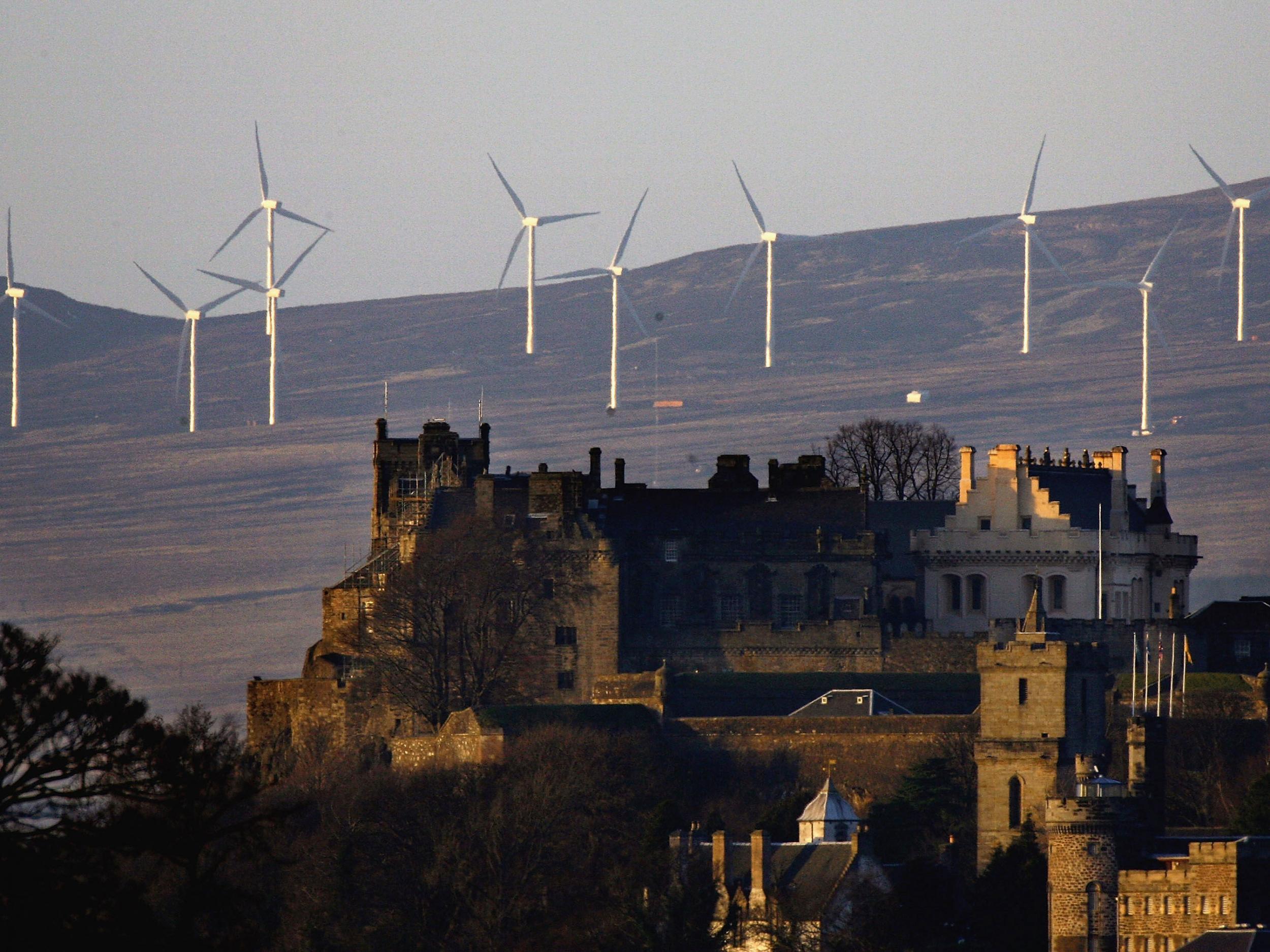Scotland just produced enough wind energy to power it for an entire day
Strong winds combined with low demand on a sunny summer Sunday help Scotland reach ‘significant milestone’ on path towards ditching fossil fuels entirely

For the first time on record, wind turbines have generated more electricity than was used in the whole of Scotland on a single day.
An analysis by conservation group WWF Scotland found unseasonably stormy weather saw turbines create about 106 per cent of the total amount of electricity used by every home and business in the country on 7 August.
Gale-force winds lashed much of the country with a speed of 115mph recorded at the top of Cairngorm mountain.
A 17,000-tonne oil rig broke away from a tug in the early hours of Monday morning and later ran aground near Carloway on the Isle of Lewis.
And train services were cancelled as trees were blown onto the tracks, various events had to be cancelled and parts of Dundee were hit by a power cut.
But WWF Scotland’s director Lang Banks said: “While Sunday’s weather caused disruption for many people, it also proved to be a good day for wind power output, with wind turbines alone providing the equivalent of all Scotland’s total electricity needs.
“This major moment was made possible thanks, in part, to many years of political support, which means that across the year now, renewables contribute well over half of our electricity needs.
“However, if we want this ensure we reap the many benefits of becoming a low-carbon economy we need to see this political support for renewables continue.”
He urged the Scottish Government to commit to a new target of supplying half of all Scotland’s energy needs – including heat and transport – from renewables by 2030.
Energy saving options in pictures
Show all 4Mr Banks said it was “not impossible that this has happened before” but they had only had enough information to calculate the figures since last year.
“On the path to a fully renewable future, this certainly marks a significant milestone,” he said.
“It should also be remembered that wind power is not the only renewable power source Scotland has at its disposal.
“If we continue to take steps to reduce our energy demand, invest in storage, and increase our use of renewables we can hopefully look forward to many days that are fully powered by nature.”
The figures showed that wind turbines in Scotland provided 39,545 megawatt hours (MWh) of electricity to the National Grid for 24 hours on Sunday. Scotland’s total electricity consumption for that day was 37,202MWh. It is unclear whether demand at any single point in the day exceeded the amount supplied by the turbines.
Karen Robinson, of the WeatherEnergy project, which provides information about renewables, said that electricity demand during weekends was “usually lower than the rest of the week”. People also tend to use less power during the summer.
“Nevertheless, the fact that wind power was able to generate the equivalent of all Scotland¹s electricity needs shows just how far renewables have come,” Ms Robinson said.
In May this year, renewable energy in Germany supplied almost all of the demand at a specific time of day, prompting power prices to turn negative during several 15-minute periods, meaning that consumers were being paid up to 50 euros (£43) per MWh to use electricity. Last year, wind energy supplied 140 per cent of demand in Denmark.
According to a new study by Bloomberg New Energy Finance (BNEF) last year, wind power generates the cheapest electricity in both the UK and Germany.
Talking about the UK-wide situation James Court, head of policy at the Renewable Energy Association, accused the Westminster Government of standing in the way of green energy.
“The UK already has 25 per cent of generation from renewables, and that was from a standing start 10 years ago,” he said.
“We are now at a point where renewables such as solar and wind are already cheaper than new gas plants; biomass and energy-from-waste are comparable to new nuclear; and grid-scale energy storage is being deployed commercially in the UK without subsidy.
“Now that renewables are cost competitive with fossil fuels, we need Government to level the playing field. Renewables are being blocked to market by Government policy, just at the time they are commercially viable.”
The Scottish Government said in a statement that the country's “abundant energy resources play a vital role in delivering security of electricity supply across the UK”.
“The Scottish Government is committed to supporting onshore wind, which is one of our most cost-effective low carbon energy technologies,” it added.
“We remain fully supportive of low-carbon technologies, which offer a huge economic opportunity for Scotland and have a key role to play in our fight against the threat posed by climate change to our society and natural environment.
“We have a clear policy for an energy mix to provide energy security for the future and will set out our ambitions for an integrated approach to low carbon technologies within our draft energy strategy later this year. This will include exploring the option of setting a new renewable energy target.”
However, the statement added: “Recent decisions taken at UK level have been damaging to key areas of the industry.
“Going forward we need both a long-term commitment and greater visibility on funding to provide certainty and confidence to developers and investors.”
Subscribe to Independent Premium to bookmark this article
Want to bookmark your favourite articles and stories to read or reference later? Start your Independent Premium subscription today.

Join our commenting forum
Join thought-provoking conversations, follow other Independent readers and see their replies